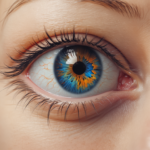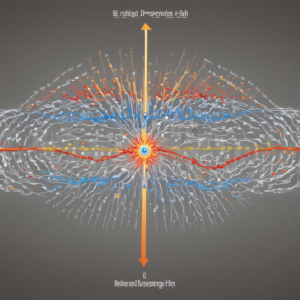Book Link 29 Vision
<back next> — index
Learning Objectives
By the end of this section, you will be able to:
• Describe the basic anatomy of the visual system
• Discuss how rods and cones contribute to different aspects of vision
• Describe how visual illusions occur in brain processing
-
Introduction
Our body’s ability to see is a fascinating process that significantly influences our thoughts and feelings. It all begins when light strikes the retina in our eyes. The retina then processes this visual information and sends it through the optic nerve to the brain. In the brain’s visual cortex, the real magic happens as the brain interprets and processes this visual information.
Rods and cones in the retina play unique roles in vision, with cones responsible for color vision and rods for night vision. Understanding concepts like color blindness promotes empathy and inclusivity in the school community. Also, understanding visual illusions and agnosia demonstrates the complexity of our visual perception and how the brain interprets visual information.
Visual System
The way we see it is remarkable. Our visual system has its special route to the brain, and it’s super important for how we think and feel. It starts at the back of the eye in the retina. When light enters the eye, it sets off cells in the retina, passing the visual information to other cells.
But here’s the cool part: unlike our other senses, like touch or smell, our vision doesn’t use the same nerve systems to talk to the brain. Instead, the visual system has its way of sending messages to the brain. It sends visual information from the retina through the optic nerve straight to the brain’s visual processing areas. This special pathway is just for our sense of sight and makes it different from all our other senses.
brain. It sends visual information from the retina through the optic nerve straight to the brain’s visual processing areas. This special pathway is just for our sense of sight and makes it different from all our other senses.
Understanding how we see is super important in psychology for many reasons. Being able to see well is a big part of how we think and feel. According to people like Piaget and Erikson, seeing and interacting with the world around us is important for our development as we grow up.
When babies are born, they can’t see very well and can only see things close to them. This limited vision can affect how babies experience the world and connect with others, especially when forming close bonds. Studies show that when babies look into their caregivers’ eyes and pay attention to their facial expressions, it helps them form strong relationships.
These early visual experiences are a big part of a baby’s emotional and social growth, setting the stage for handling relationships and emotions as they age.
According to Bowlby, babies look at and copy their parents’ facial expressions to feel safe and loved. Facial recognition helps infants form a strong bond with their caretakers. Bowlby’s theory says these early interactions are important for babies’ emotional growth and getting along with others later in life.
Facial recognition helps infants form a strong bond with their caretakers. Bowlby’s theory says these early interactions are important for babies’ emotional growth and getting along with others later in life.
Also, it’s important to understand how our eyes and brain work together to study how people think, pay attention, remember things, and learn. How we see things affects how we understand and react to the world. So, knowing how we see things helps us understand how people behave, think, and develop emotions as they grow up.
Rods and Cones
Rods work in low light and don’t see colors well, while cones work in bright sunlight, see colors, and are good at seeing fine details. The central part of the retina called the fovea, has only cones.
Rods and cones, two distinct types of photoreceptor cells in the eye’s retina, play unique roles in vision. Highly light-sensitive rods are crucial for night vision but do not perceive color. On the other hand, less light-sensitive cones are responsible for color vision and detecting fine details, working best in bright light. The fovea, a central part of the retina, contains only cones, making it responsible for the sharpest vision.
 Despite having cones, color-blind individuals may have a deficiency in one or more types of cone cells. This deficiency can lead to a reduced ability to perceive certain colors. The most common form of color blindness, red-green color blindness, is caused by a lack of either the red or green cone pigments in the eyes. As a result, individuals with color blindness may have difficulty distinguishing between certain colors.
Despite having cones, color-blind individuals may have a deficiency in one or more types of cone cells. This deficiency can lead to a reduced ability to perceive certain colors. The most common form of color blindness, red-green color blindness, is caused by a lack of either the red or green cone pigments in the eyes. As a result, individuals with color blindness may have difficulty distinguishing between certain colors.
Cones and rods, which are not nerve cells themselves, transmit electrical and chemical signals to the bipolar cells, which are considered nerve cells. The bipolar cells then transmit information to the ganglion and nerve cells.
The axons from the ganglion cells send signals to the dendrites or cell bodies of other cells across a synapse (or gap). The ganglion cells and their axons are bundled into the optic nerve, a fascinating structure that transmits these signals to the brain for processing, leading to the perception of vision.
The part of the brain that processes vision is called the visual cortex. It’s located in the occipital lobe at the back of the brain. Visual information processing occurs in the visual cortex, enlightening us about the visual world. Different areas within the visual cortex are responsible for various aspects of visual perception, such as color, motion, form, and depth.
Understanding these concepts applies to all of us. Learning about color blindness and the role of cone deficiency in perceiving certain colors can foster empathy and understanding among high school students toward their peers who may have color vision deficiencies. This knowledge can encourage inclusivity and a supportive environment within the school community and beyond.
Visual Illusions, Perception, and Agnosia
Visual illusions are the brain’s misinterpretation of visual information, akin to a miscommunication between the brain and the eyes. Visual agnosia is the inability to recognize objects despite normal visual abilities, memory, and language.

 Objects are recognized visually in two ways. The first is apperceptive recognition, where features of an object have a meaning.
Objects are recognized visually in two ways. The first is apperceptive recognition, where features of an object have a meaning.
The second is associative recognition, where the object is identified based on meaning.
————————————
Most people recognize objects in both ways, but some recognize objects in only one of these ways.
Visual illusions are the brain’s misinterpretation of visual information, which can be likened to a miscommunication between the brain and the eyes. Sometimes, the brain plays a game of ‘guess what I’m seeing,’ leading to optical illusions. The brain and eyes can be likened to two friends trying to converse in different languages, with the brain interpreting something different from what the eyes intend.
One form of impairment related to visual recognition is visual agnosia, which is the inability to recognize visually presented objects despite normal visual field, acuity, color vision, brightness discrimination, language, and memory. Individuals with visual agnosia can still perceive objects using other sensory modalities.
The visual cortex processes the information in the occipital lobe, the brain’s command center for processing visual data. Recognition of visual objects occurs at two primary levels: apperceptive and associative. At the apperceptive level, features of visual information are assembled to form a perceptual representation of an object. At the associative level, the meaning of an object is linked to the perceptual representation, and the object is identified.
Real-life examples
Example: A Teenager’s Struggle and Trauma
Imagine a teenager who has gone through a tough experience and finds it hard to deal with their emotions and connect with others. Knowing how our eyes and brain work together can help us understand why they might struggle.
 For example, if the teenager has a tough time looking at people’s faces or understanding their emotions because of what they’ve been through, it could make it harder for them to build strong relationships.
For example, if the teenager has a tough time looking at people’s faces or understanding their emotions because of what they’ve been through, it could make it harder for them to build strong relationships.
Learning about how our brains process what we see can also show us how their past experiences affect how we see the world.
Understanding these things can help us be more understanding and supportive as they work through their tough time.
Example: Therapist and Patient
Imagine a scenario where a vision therapist works closely with a patient who is an aspiring graphic designer with color blindness. The therapist develops a tailored vision therapy program focused on enhancing the patient’s color perception and differentiation skills, recognizing the critical importance of color in design.
Together, the patient and therapist engage in practical exercises and utilize specialized visual processing techniques to simulate real-world design scenarios, specifically focusing on color-matching activities and integrating adaptive technologies into the design workflow.
 The therapist also provides ongoing guidance on incorporating accessible color palettes and leveraging design software features to accommodate the patient’s color vision deficiencies, empowering them to apply their newly acquired skills to their design projects.
The therapist also provides ongoing guidance on incorporating accessible color palettes and leveraging design software features to accommodate the patient’s color vision deficiencies, empowering them to apply their newly acquired skills to their design projects.
As the therapy progresses, the patient experiences tangible improvements in their ability to discern and work with colors, leading to newfound confidence and professional growth. The collaborative efforts of the patient and therapist result in enhanced color perception and provide the patient with valuable insights into leveraging their unique perspective as a designer with color blindness, turning what was once a challenge into a source of creative inspiration and innovation in their work.
Example: Human Factors Psychology
Imagine a human factors psychologist working with a team to design a new user interface for a medical device. The psychologist knows that people have different abilities to see colors and wants to ensure the design is easy for everyone, including those with color vision deficiencies.
The psychologist starts by looking into how people see colors and what difficulties might come up for those with color vision deficiencies. Using this knowledge, the psychologist helps the team choose colors and design features that work well for people with different ways of seeing colors, making the interface easy to use and understand.
 As the design progresses, the psychologist works with the designers to add different visual clues and feedback besides colors. This makes the interface clear for everyone, no matter how they see colors. After the design is done, the psychologist tests it with people with different ways of seeing colors, ensuring the interface works well for everyone.
As the design progresses, the psychologist works with the designers to add different visual clues and feedback besides colors. This makes the interface clear for everyone, no matter how they see colors. After the design is done, the psychologist tests it with people with different ways of seeing colors, ensuring the interface works well for everyone.
Ultimately, the psychologist’s work helps the team create a user interface that’s easy to use for people with different ways of seeing colors. This makes the medical device accessible to more users, showing how thinking about diverse visual abilities can lead to better designs for everyone.
Psychological Theorists
Several well-known psychology theorists have published works on the psychological implications of visual processes and perception.
Richard Gregory studied perception and illusions. His book Eye and Brain: The Psychology of Seeing delves into the interactions between visual perception and the brain’s visual information processing.
Hermann von Helmholtz researched vision and color perception, which laid the foundation for contemporary theories of visual processing.
Other Gestalt psychologists, such as Max Wertheimer, Kurt Koffka, and Wolfgang Köhler, have contributed to our understanding of visual perception and its psychological implications. Their work highlights the role of perceptual organization and pattern recognition in shaping our visual experiences. It sheds light on the relationship between the mind and vision.
Summary
This module discusses the basic anatomy of the visual system, the roles of rods and cones in vision, and how visual illusions are processed in the brain. It points out the importance of understanding how we see and perceive the world. For example, this module speaks about color blindness, early visual experiences, and the impact of vision on emotional and social development.
It also explains the functions of rods and cones in the retina, their roles in night vision and color vision, and the transmission of visual information to the brain for processing. Overall, the module provides an overview of the visual system, its impact on human development, and the complexities of visual perception.
 Additionally, this module dives into the specifics of rods and cones in the retina, highlighting their unique functions. It explains that rods are crucial for night vision but don’t see colors well. At the same time, cones are responsible for color vision and detecting fine details, particularly in bright light.
Additionally, this module dives into the specifics of rods and cones in the retina, highlighting their unique functions. It explains that rods are crucial for night vision but don’t see colors well. At the same time, cones are responsible for color vision and detecting fine details, particularly in bright light.
The occurrence of color blindness is also discussed, emphasizing that individuals with this condition may have difficulty perceiving certain colors due to deficiencies in specific cone cells.
The text describes the transmission of signals from rods and cones to the bipolar cells, ganglion cells, and the optic nerve, and then information processing in the brain’s visual cortex. In addition to providing an overview, this text explains the roles of rods and cones, color vision, and the transmission of visual signals to the brain.